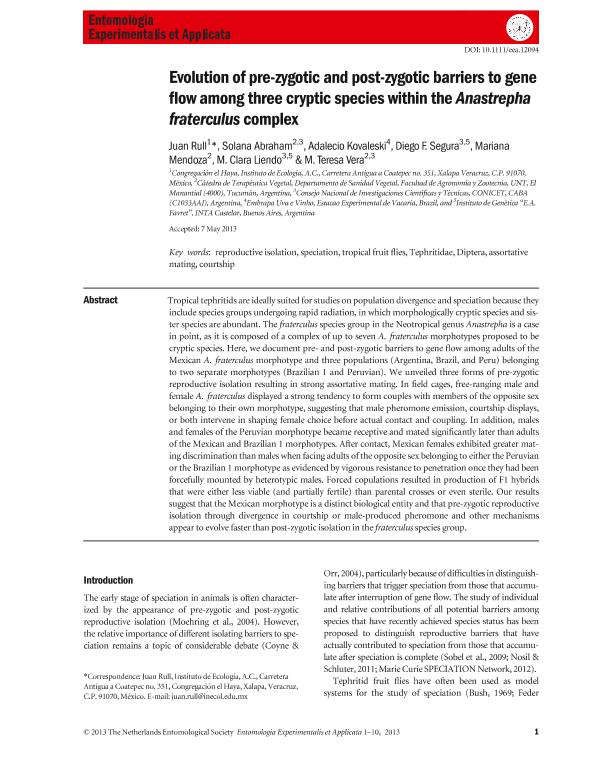Mostrar el registro sencillo del ítem
dc.contributor.author
Rull Gabayet, Juan Antonio

dc.contributor.author
Abraham, Solana

dc.contributor.author
Kovaleski, Adalesio
dc.contributor.author
Segura, Diego Fernando

dc.contributor.author
Mendoza, Mariana
dc.contributor.author
Liendo, María Clara

dc.contributor.author
Vera, Maria Teresa

dc.date.available
2016-08-29T15:39:05Z
dc.date.issued
2013-06
dc.identifier.citation
Rull Gabayet, Juan Antonio; Abraham, Solana; Kovaleski, Adalesio; Segura, Diego Fernando; Mendoza, Mariana; et al.; Evolution of pre-zygotic and post-zygotic barriers to gene flow among three cryptic species within the Anastrepha fraterculus complex; Wiley; Entomologia Experimentalis Et Applicata; 148; 3; 6-2013; 213-222
dc.identifier.issn
0013-8703
dc.identifier.uri
http://hdl.handle.net/11336/7328
dc.description.abstract
Tropical tephritids are ideally suited for studies on population divergence and speciation because they include species groups undergoing rapid radiation, in which morphologically cryptic species and sister species are abundant. The fraterculus species group in the Neotropical genus Anastrepha is a case in point, as it is composed of a complex of up to seven A. fraterculus morphotypes proposed to be cryptic species. Here, we document pre- and post-zygotic barriers to gene flow among adults of the Mexican A. fraterculus morphotype and three populations (Argentina, Brazil, and Peru) belonging to two separate morphotypes (Brazilian 1 and Peruvian). We unveiled three forms of pre-zygotic reproductive isolation resulting in strong assortative mating. In field cages, free-ranging male and female A. fraterculus displayed a strong tendency to form couples with members of the opposite sex belonging to their own morphotype, suggesting that male pheromone emission, courtship displays, or both intervene in shaping female choice before actual contact and coupling. In addition, males and females of the Peruvian morphotype became receptive and mated significantly later than adults of the Mexican and Brazilian 1 morphotypes. After contact, Mexican females exhibited greater mating discrimination than males when facing adults of the opposite sex belonging to either the Peruvian or the Brazilian 1morphotype as evidenced by vigorous resistance to penetration once they had been forcefully mounted by heterotypic males. Forced copulations resulted in production of F1 hybrids that were either less viable (and partially fertile) than parental crosses or even sterile. Our results suggest that the Mexican morphotype is a distinct biological entity and that pre-zygotic reproductive isolation through divergence in courtship or male-produced pheromone and other mechanisms appear to evolve faster than post-zygotic isolation in the fraterculus species group.
dc.format
application/pdf
dc.language.iso
eng
dc.publisher
Wiley

dc.rights
info:eu-repo/semantics/openAccess
dc.rights.uri
https://creativecommons.org/licenses/by-nc-sa/2.5/ar/
dc.subject
Reproductive Isolation
dc.subject
Speciation
dc.subject
Tropical Fruit Flies
dc.subject
Tephritidae
dc.subject.classification
Zoología, Ornitología, Entomología, Etología

dc.subject.classification
Ciencias Biológicas

dc.subject.classification
CIENCIAS NATURALES Y EXACTAS

dc.title
Evolution of pre-zygotic and post-zygotic barriers to gene flow among three cryptic species within the Anastrepha fraterculus complex
dc.type
info:eu-repo/semantics/article
dc.type
info:ar-repo/semantics/artículo
dc.type
info:eu-repo/semantics/publishedVersion
dc.date.updated
2016-08-11T19:38:44Z
dc.journal.volume
148
dc.journal.number
3
dc.journal.pagination
213-222
dc.journal.pais
Reino Unido

dc.journal.ciudad
Londres
dc.description.fil
Fil: Rull Gabayet, Juan Antonio. Instituto de Ecologia; México
dc.description.fil
Fil: Abraham, Solana. Universidad Nacional de Tucumán. Facultad de Agronomía y Zootecnia. Cátedra. Terapéutica Vegetal; Argentina. Consejo Nacional de Investigaciones Científicas y Técnicas. Centro Científico Tecnológico Tucumán; Argentina
dc.description.fil
Fil: Kovaleski, Adalesio. Estacao Experimental de Vacaria. Embrapa Uva e Vinho; Brasil
dc.description.fil
Fil: Segura, Diego Fernando. Instituto Nacional de Tecnología Agropecuaria. Centro Nacional de Investigaciones Agropecuarias. Centro de Investigación de Ciencias Veterinarias y Agronómicas. Instituto de Genética; Argentina. Consejo Nacional de Investigaciones Científicas y Técnicas; Argentina
dc.description.fil
Fil: Mendoza, Mariana. Universidad Nacional de Tucumán. Facultad de Agronomía y Zootecnia; Argentina
dc.description.fil
Fil: Liendo, María Clara. Instituto Nacional de Tecnología Agropecuaria. Centro Nacional de Investigaciones Agropecuarias. Centro de Investigación de Ciencias Veterinarias y Agronómicas. Instituto de Genética; Argentina. Consejo Nacional de Investigaciones Científicas y Técnicas; Argentina
dc.description.fil
Fil: Vera, Maria Teresa. Universidad Nacional de Tucumán. Facultad de Agronomía y Zootecnia. Cátedra. Terapéutica Vegetal; Argentina. Consejo Nacional de Investigaciones Científicas y Técnicas. Centro Científico Tecnológico Tucumán; Argentina
dc.journal.title
Entomologia Experimentalis Et Applicata

dc.relation.alternativeid
info:eu-repo/semantics/altIdentifier/url/http://onlinelibrary.wiley.com/doi/10.1111/eea.12094/abstract
dc.relation.alternativeid
info:eu-repo/semantics/altIdentifier/doi/http://dx.doi.org/10.1111/eea.12094
Archivos asociados
